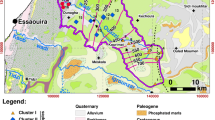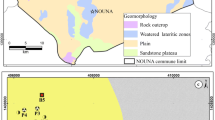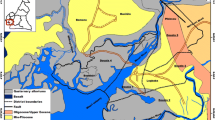Abstract
Groundwater is a critical resource in Deoria district, as it is the main source of drinking water and irrigation. The aquifer has deteriorated to a high degree, during the last two to three decades, in quality and quantity due to high population growth and environmental pollution. More than 90% of the population get their drinking water from subsurface waters. Fifteen wells were sampled in June 2006 to probe the hydrogeochemical components that influence the water quality. The results show that groundwater have EC, TDS, Na+, Mg2+, HCO −3 and TH higher than the WHO, 1997 maximum desirable limits. A hydrogeochemical numerical model for carbonate minerals was constructed using the PHREEQC package. The regression analysis shows that there are three groups of elements which are significantly and positively correlated. The main hydrochemical facies of the aquifer (Ca + Mg–HCO3) represents 33.33% of the total wells. The geochemical modeling demonstrated that the reactions responsible for the hydrochemical evolution in the area fall into three categories: (1) dissolution of salts, (2) precipitation of dolomite, (3) ion exchange. Solubility of dolomite, calcite, aragonite and gypsum were assessed in terms of the saturation index. The thermodynamic prerequisites for dolomite supersaturation reactions are satisfied by subsurface waters, since they are supersaturated with respect to dolomite, undersaturated (or in equilibrium) with respect to calcite, and undersaturated with respect to gypsum. The Ca2+ versus SO 2−4 and Mg2+ versus SO 2−4 trends are also compatible with homologous trends resulting from dolomite supersaturation.







Similar content being viewed by others
References
American Public Health Association (1992) Standard methods for the examination of water and wastewater, 19th edn. APHA, Washington, DC
American Public Health Association (1998) Standard methods for the examination of water and wastewater, 20th edn. APHA, Washington, DC
Appelo CAJ, Postma D (1993) Geochemistry, groundwater and pollution. AA Balkema, Rotterdam
Balasubramanian A, Sharma KK, Sastri JCV (1985) Geoelectrical and hydrogeochemical evaluation of coastal aquifer of Tambraparni basin, Tamilnadu. Geophysics Res B 23:203–209
Blatt H (1992) Sedimentary petrology, 2nd edn. W.H. Freeman and Company, New York
Capo RC, Whipkey CE, Blachere J, Chadwick OA (2000) Pedogenic origin of dolomite in a basaltic weathering profile, Kohala, Peninsula, Hawaii. Geology 28:271–274
Chidambarm S, Ramanathan AL (2000) Ph.D. Thesis, Annamalai University, Tamil Nadu, India
Datta PS, Bhattacharya SK, Tyagi SK (1996) 18O studies on recharge of phreatic aquifers and groundwater flow paths of mixing in Delhi area. J Hydrol 176:25–36
Drever JI (1988) The geochemistry of natural waters. Prentice Hall, Englewood Cliffs
Garrels RM, Mackenzie FT (1971) Gregor’s denudation of the continents. Nature 231:382–383
Guler C, Thyne GD, McCray JE, Turner AK (2002) Evaluation of graphical and multivariate statistical methods for classification of water chemistry data. Hydrogeol J 10:455–474
Kuells C, Adar EM, Udluft P (2000) Resolving patterns of ground water flow by inverse hydrochemical modeling in a semiarid Kalahari basin. Tracers. Model Hydrogeol 262:447–451
Kumar S, Singh IB, Singh M, Singh DS (1995) Depositional pattern in upland surface of Central Ganga Plain near Lucknow. J Geol Soc India 46:545–555
Lawrence FW, Upchurch SB (1982) Identification of recharge areas using geochemical factor analysis. Ground Water 20:680–687
Mohindra R, Parkash B (1990) Clay mineralogy of the soils of Gandak megafan and adjoining area, Middle Gangetic Plain, India. Proc 9th int Sci geol Bull 43(2-3):193–203
Pacheco FAL, Szocs T (2006) “Dedolomitization Reactions” driven by anthropogenic activity on loessy Sediments, SW Hungary. Appl Geochem 21:614–631
Pandey SK, Singh AK, Hasnain SI (2001) Hydrochemical characteristics of meltwater draining from Pindari glacier, Kumon Himalaya. J Geol Soc India 57:519–527
Parkhurst DL, Appelo CAJ (1999). User’s guide to PHREEQC (Version 2.14.2)—a computer program for speciation, batch-reaction, one-dimensional transport, and inverse geochemical calculations. USGS water resource investigation report. 99–4259
Pascoe EH (1917) A manual of geology of India and Burma. Gov. India Publ, Delhi
Plummer LN, Back WW (1980) The mass balance approach-application to interpreting the chemical evolution of hydrological systems. Am J Sci 280:130–142
Plummer LN, Parkhurst DL, Thorstenson DC (1983) Development of reaction models for ground-water systems. Geochim Cosmochim Acta 47:665–686
Portela EAC, Lopes H, Cardoso C (1993) A estrumac¸a˜o no sistema de agricultura de montanha do Barroso, v. 2 – Estrumes e seu valor fertilizante. Technical Report (estudos camar 6), Departamento de Economia e Sociologia, Tra′s-os-Montes e Alto Douro University, Vila Real, 39 pp
Sarin MM, Krishnaswamy S, Dilli K, Somayajulu BLK, Moore WS (1989) Major ion chemistry of the Ganga–Brahmaputra river system: weathering processes and fluxes to the Bay of Bengal. Geochim Cosmochim Acta 53:997–1009
Singh DS (1998) Sedimentology of Gandak Megafan, Ganga Plain. PhD Thesis, University of Lucknow, India
Singh AK, Hasnain SI (1998) Major ion chemistry and control of weathering in a high altitude basin, Alaknanda, Garhwal Himalaya, India. Hydrol Sci J 43:825–845
Singh DS, Singh IB (2005) Facies architecture of the Gandak Megafan, Ganga Plain, India. Special Publication of Palaeontol Soc India 2:125–140
Singh IB, Ansari AA, Chandel RS, Misra A (1996) Neotectonic control on drainage system in Gangetic plain, Uttar Pradesh. J Geol Soc India 45:599–609
Singh IB, Srivastava P, Shukla U, Sharma S, Sharma M, Singh DS, Rajagopalan G (1999) Upland interfluve (Doab) deposition: Alternative model to muddy overbank deposits. Facies 40:197–210
Stumm W, Morgan JJ (1981) Aquatic chemistry. Wiley Interscience, New York
Subba Rao N (2002) Geochemistry of groundwater in parts of Guntur district, Andhra Pradesh. India Environ Geol 41:552–562
Thomas JM, Welch AH, Preissler AM (1989) Geochemical evolution of ground water in Smith Creek Valley—a hydrologically closed basin in central Nevada. USA Appl Geochem 4:493–510
Acknowledgments
The financial assistance from Department of Science and Technology, Government of India, New Delhi is highly acknowledged (Project No—SR/54/ES-21/Ganga Plain/P3). We thank the Head, Centre of Advanced Study in Geology, University of Lucknow for providing the working facilities. Thanks are also expressed to the Central Ground Water Board and Ground Water Directorate for providing the necessary data and USGS for providing PHREEQC software.
Author information
Authors and Affiliations
Corresponding author
Rights and permissions
About this article
Cite this article
Bhardwaj, V., Singh, D.S. & Singh, A.K. Hydrogeochemistry of groundwater and anthropogenic control over dolomitization reactions in alluvial sediments of the Deoria district: Ganga plain, India. Environ Earth Sci 59, 1099–1109 (2010). https://doi.org/10.1007/s12665-009-0100-y
Received:
Accepted:
Published:
Issue Date:
DOI: https://doi.org/10.1007/s12665-009-0100-y




